| GNSS | |
GNSS Constellation Specific Monthly Analysis Summary: June 2025
The analysis performed in this report is solely his work and own opinion. State Program: U.S.A (G); EU (E); China (C) “Only MEO- SECM satellites”; Russia (R); Japan (J); India (I) |
 |
|
Introduction
This article continues the monthly performance analysis of the GNSS constellation. Readers are encouraged to refer to previous issues for foundational discussions and earlier results. As a complementary extension to last month’s article on the application of variational equations in parameter estimation, this issue includes a focused analysis on reduced-dynamic orbit determination. Specifically, it will explore how satellite orbits—such as those of LEO missions—can be estimated by combining GNSS observations with physical models of orbital dynamics, supported by the solution of variational equations. This approach bridges the gap between purely kinematic and fully dynamic orbit determination, offering a robust framework for high precision orbit estimation even in the presence of data gaps or modeling uncertainties.
Analyzed Parameters for June 2025
(Dhital et. al, 2024) provides a brief overview of the necessity and applicability of monitoring the satellite clock and orbit parameters.
a..Satellite Broadcast Accuracy, measured in terms of Signal-In Space Range Error (SISRE) (Montenbruck et. al, 2010).
b. SISRE-Orbit (only orbit impact on the range error), SISRE (both orbit and clock impact), and SISRE-PPP (as seen by the users of carrier phase signals, where the ambiguities absorb the unmodelled biases related to satellite clock and orbit estimations. Satellite specific clock bias is removed)
c. Clock Discontinuity: The jump in the satellite clock offset between two consecutive batches of data uploads from the ground mission segment. It is indicative of the quality of the satellite atomic clock and associated clock model.
d. URA: User Range Accuracy as an indicator of the confidence on the accuracy of satellite ephemeris. It is mostly used in the integrity computation of RAIM.
e. GNSS-UTC offset: It shows stability of the timekeeping of each constellation w.r.t the UTC
f. Galileo Constellation Anomaly, May, 2025: The degradation in some of the Galileo satellites is cross-checked with satellite health status and corresponding integrity threshold.
Note:– for India’s IRNSS there are no precise satellite clocks and orbits as they broadcast only 1 frequency which does not allow the dual frequency combination required in precise clock and orbit estimation; as such, only URA and Clock Discontinuity is analyzed.

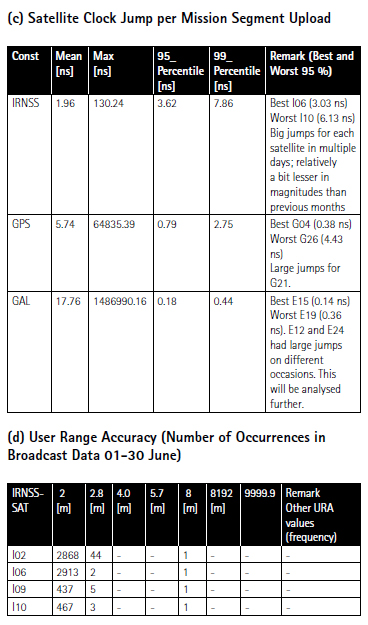
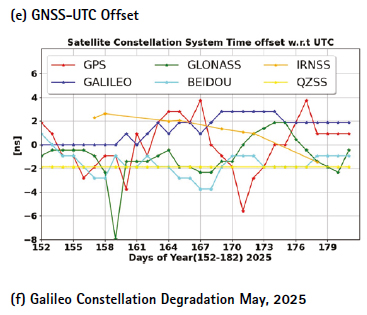
(f) Galileo Constellation Degradation May, 2025
Although the NAGU was released, the full details on the degradation of satellites from 12th May to 19th May are not available yet. Not surprisingly, there is a strong concern from the community regarding the transparency of the Galileo service operations as indicated by the following questions raised to the European Commission (source: https://www.europarl.europa.eu/doceo/ document/E-10-2025-002019_EN.html#:~:text=Galileo%2C%20 the%20EU’s%20global%20navigation,3.)
“Galileo, the EU’s global navigation satellite system, is central to the EU’s drive for technological sovereignty. However, recent observations by experts raise doubts about system performance and institutional transparency. On 7 May 2025, the EU Agency for the Space Programme (EUSPA) issued a notice[1] warning of potential service degradation ‘up to (…) disruption of service’ without a clear explanation. Moreover, an independent observer has reported that multiple satellites are broadcasting outdated data, potentially causing positioning errors affecting navigation and transport. At the same time, cryptographic authentication appears to be malfunctioning, weakening safeguards against spoofing and giving rise to concerns about secure use in critical services such as emergency response.
1. Can the Commission confirm the nature and scope of the reported system issues, including outdated satellite data and authentication malfunctions, and clarify what steps have been taken to mitigate risks to users?
2. What measures is the Commission taking to ensure the continuous accuracy and integrity of Galileo’s broadcast data, especially in the light of recent anomalies?
3. What protocols are in place to ensure timely and transparent communication with users and researchers during service degradations, and does the Commission consider the recent EUSPA notice adequate in this regard?”
In the monthly performance analysis reported for May, there were Signal-In-Space degradation, triggered by satellite clock error, observed for multiple satellites. The goal in this section is to analyse the message contents of the broadcast navigation and correlate the health status indicator to the computed performance. The integrity parameter, inflation factor K, derived from the probability of the satellite fault event is used together with Signal In Space Accuracy (SISA) value and compared against the SISRE. If the SISRE is above K times SISA and satellite is indicated as healthy, then it is a satellite fault event not captured by the system. The detail discussion on this approach was provided in the monthly performance analysis report in June and July, 2024 (Dhital et.al, 2024b). Readers are encouraged to go through those articles as the computation details and concepts are not provided in this section. In the following, only the relevant plots and analysis of the observed phenomenon are included to be succinct.
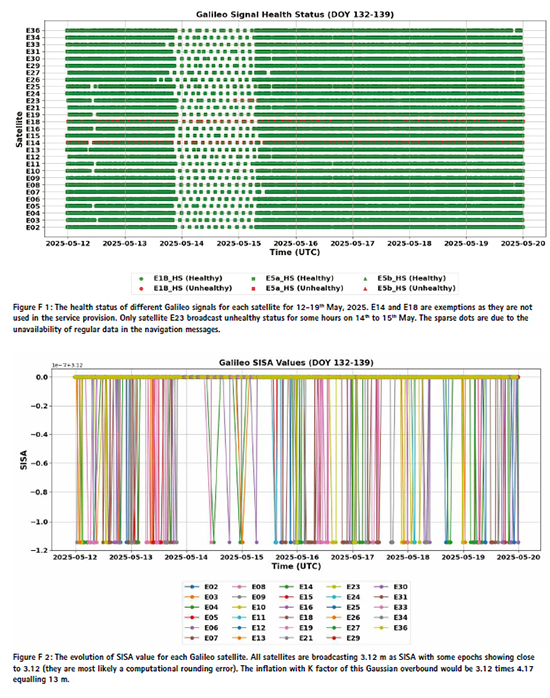
Figure F1 shows the evolution of the satellite health status from the 12th May until the 19th May, 2025. As E14 and E18 are exception satellites that are not used in the service provision, only E23 appears to show unhealthy status for few hours on the 15th and 16th of May. This suggests that during the constellation testing phase (as mentioned in the NAGU) the satellites were set as healthy and to be used for the services with expected performance degradation. However, if the satellite errors are exceeding the integrity level supported by the inflation factor K=4.17 to over bound the Gaussian distribution of the accuracy provided by SISA, it is to be noted as satellite fault event. The SISA value broadcast by the satellite is the Gaussian Overbound of the expected accuracy of the satellite system coming from clock and orbit errors. Figure F2 shows that all satellites were transmitting nominal value of 3.12 m for most of the time. On occasions they sent close to 3.12 m which is negligible and likely be the computational rounding error. The inflated overbound is 3.12 times 4.17 (inflation factor K) equaling around 13 m. The goal here is to check if the satellite SISRE between 12th and 19th May went over 13 m for any instance.
It is observed that the threshold of 13 m was never crossed and even on the most degraded day on the 14th and 15th, May, the SISRE for individual satellite was far below the threshold.
The inflated over bound based on above Figure F 2 is now compared against the computed the SISRE from Figure F3 and F4 (for 14th and 15th May, respectively). It is clearly visible that the SISRE for most of the satellites went higher from the mid-day on the 14th and stayed elevated until the mid-day 15th May. However, the higher errors never came near to the threshold of 13 m. This indicates that there was no satellite fault event during the Galileo constellation degradation between 12th to 19th May, 2025.
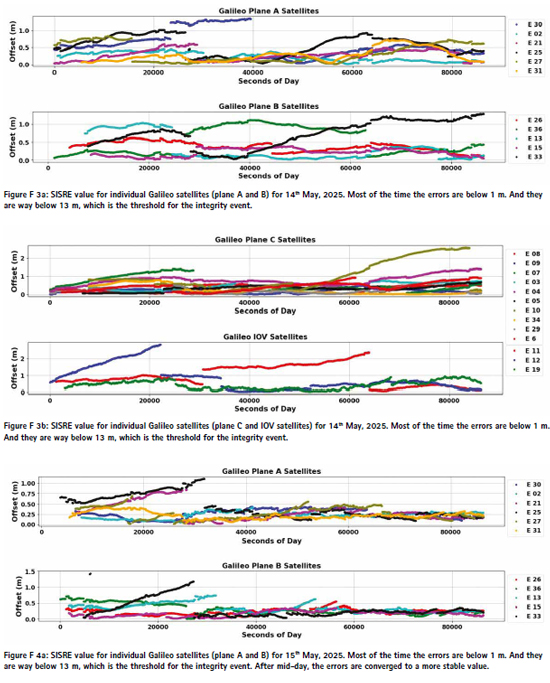
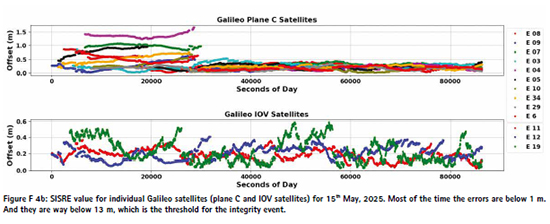
Monthly Performance Remarks:
1. Satellite Clock and Orbit Accuracy:
▪ The performance of GLONASS degraded by 10-15 cm. For other constellation, the overall performance looked similar to past month.
▪ There were a couple of satellite clock jumps for both GPS and Galileo constellations. They will be analyzed in future issues.
▪ The URA and satellite clock discontinuity for IRNSS showed some improvement. The URA values are less scattered than previous month. Only URA 2, 2.8 and 8 are broadcast.
▪ UTC Prediction (GNSS-UTC): ▪ All constellations except GLONASS reported relatively stable and consistent UTC predictions.
References
Alonso M, Sanz J, Juan J, Garcia, A, Casado G (2020) Galileo Broadcast Ephemeris and Clock Errors Analysis: 1 January 2017 to 31 July 2020, MDPI
Alonso M (2022) Galileo Broadcast Ephemeris and Clock Errors, and Observed Fault Probabilities for ARAIM, Ph.D Thesis, UPC
Bento, M (2013) Development and Validation of an IMU/GPS/Galileo Integration Navigation System for UAV, PhD Thesis, UniBW.
BIMP (2024 a) https://e-learning.bipm. org/pluginfile.php/6722/mod_label/ intro/User_manual_cggtts_analyser. pdf?time=1709905608656
BIMP (2024 b) https://e-learning. bipm.org/mod/folder/view. php?id=1156&forceview=1
BIMP (2024 c) https://cggtts analyser.streamlit.app
Bruggemann, Troy & Greer, Duncan & Walker, R.. (2011). GPS fault detection with IMU and aircraft dynamics. IEEE Transactions on Aerospace and Electronic Systems – IEEE TRANS AEROSP ELECTRON SY. 47. 305-316. 10.1109/TAES.2011.5705677.
Cao X, Zhang S, Kuang K, Liu T (2018) The impact of eclipsing GNSS satellites on the precise point positioning, Remote Sensing 10(1):94
Chen, K., Chang, G. & Chen, C (2021) GINav: a MATLAB-based software for the data processing and analysis of a GNSS/IMU integrated navigation system. GPS Solut 25, 108. https:// doi.org/10.1007/s10291-021-01144-9
Curran, James T. & Broumendan, Ali. (2017). On the use of Low-Cost IMUs for GNSS Spoofing Detection in Vehicular Applications.
Dhital N (2024) GNSS constellation specific monthly analysis summary, Coordinates, Vol XX, Issue 1, 2, 3, 4
Dhital N (2025) GNSS constellation specific monthly analysis summary, Coordinates, Vol XXI, Issue 1
GINAv (2025). https://geodesy.noaa. gov/gps-toolbox/GINav.shtml
Goercke, L (2017) GNSS-denied navigation of fixed-wing aircraft using low-cost sensors and aerodynamic motion models, PhD Thesis, TUM.
GROOPS (2025) GROOPS Documentation and Cookbook. https://groops-devs. github.io/groops/html/index.html
Guo, Jing & Chen, Guo & Zhao, Qile & Liu, Jingnan & Liu, Xianglin. (2017). Comparison of solar radiation pressure models for BDS IGSO and MEO satellites with emphasis on improving orbit quality. GPS Solutions. 21. 10.1007/s10291-016-0540-2.
Guo F, Zhang X, Wang J (2015) Timing group delay and differential code bias corrections for BeiDou positioning, J Geod,
Hauschlid A, Montenbruck O (2020) Precise real-time navigation of LEO satellites using GNSS broadcast ephemerides, ION
IERS C04 (2024) https://hpiers.obspm.fr/ iers/eop/eopc04/eopc04.1962-now
IGS (2019) GNSS Attitude Quaternions Exchange using ORBEX
IGS (2021) RINEX Version 4.00 https://files.igs.org/pub/data/ format/rinex_4.00.pdf
InsideGNSS (2024) Working papers: upgrading galileohttps://insidegnss.com/ working-papers-upgrading-galileo/
Jiabo G, Xingyu Z, Yan C, Mingyuan Z (2021) Precision Analysis on Reduced-Dynamic Orbit Determination of GRACE-FO Satellite with Ambiguity Resolution, Journal of Geodesy and Geodynamics (http://www. jgg09.com/EN/Y2021/V41/I11/1127)
Kj, Nirmal & Sreejith, A. & Mathew, Joice & Sarpotdar, Mayuresh & Suresh, Ambily & Prakash, Ajin & Safonova, Margarita & Murthy, Jayant. (2016). Noise modeling and analysis of an IMU-based attitude sensor: improvement of performance by filtering and sensor fusion. 99126W. 10.1117/12.2234255.
Li M, Wang Y, Li W (2023) performance evaluation of real-time orbit determination for LUTAN-01B satellite using broadcast earth orientation parameters and multi GNSS combination, GPS Solutions, Vol 28, article number 52
Li W, Chen G (2023) Evaluation of GPS and BDS-3 broadcast earth rotation parameters: a contribution to the ephemeris rotation error Montenbruck
Liu, Yue & Liu, Fei & Gao, Yang & Zhao, Lin. (2018). Implementation and Analysis of Tightly Coupled Global Navigation Satellite System Precise Point Positioning/Inertial Navigation System (GNSS PPP/IMU) with IMUufficient Satellites for Land Vehicle Navigation. Sensors. 18. 4305. 10.3390/s18124305.
Mayer-Guerr, T., Behzadpour, S., Eicker, A., Ellmer, M., Koch, B., Krauss, S., Pock, C., Rieser, D., Strasser, S., Suesser Rechberger, B., Zehentner, N., Kvas, A. (2021). GROOPS: A software toolkit for gravity field recovery and GNSS processing. Computers & Geosciences, 104864. https:// doi.org/10.1016/j.cageo.2021.104864
Montenbruck O, Steigenberger P, Hauschlid A (2014) Broadcast versus precise ephemerides: a multi-GNSS perspective, GPS Solutions
Liu T, Chen H, Jiang Weiping (2022) Assessing the exchanging satellite attitude quaternions from CNES/CLS and their application in the deep eclipse season, GPS Solutions 26(1
Montenbruck O, Steigenberger P (2024) The 2024 GPS accuracy improvement initiatives, GPS Solutions
Montenbruck O, Steigenberger P, Hauschlid A (2014) Broadcast versus precise ephemerides: a multi-GNSS perspective, GPS Solutions
Montenbruck O, Hauschlid A (2014 a) Differential Code Bias Estimation using Multi-GNSS Observations and Global Ionosphere Maps, ION
Montenbruck, O., Schmid, R., Mercier, F., Steigenberger, P., Noll, C., Fatkulin, R., Kogure, S. & Ganeshan, A.S. (2015) GNSS satellite geometry and attitude models. Advances in Space Research 56(6), 1015 1029. DOI: 10.1016/j.asr.2015.06.019
Niu, Z.; Li, G.; Guo, F.; Shuai, Q.; Zhu, B (2022) An Algorithm to Assist the Robust Filter for Tightly Coupled RTK/IMU Navigation System. Remote Sens. 2022, 14, 2449. https://doi.org/10.3390/rs14102449
Schmidt, G, Phillips, R (2010) IMU/ GPS Integration Architecture Performance Comparisons. NATO.
Steigenberger P, Montenbruck O, Bradke M, Ramatschi M (2022) Evaluation of earth rotation parameters from modernized GNSS navigation messages, GPS Solutions 26(2)
Strasser S (2022) Reprocessing Multiple GNSS Constellations and a Global Station Network from 1994 to 2020 with the Raw Observation Approach, PhD Thesis, Graz University of Technology
Suvorkin, V., Garcia-Fernandez, M., González-Casado, G., Li, M., & Rovira-Garcia, A. (2024). Assessment of Noise of MEMS IMU Sensors of Different Grades for GNSS/IMU Navigation. Sensors, 24(6), 1953. https:// doi.org/10.3390/s24061953
Sylvain L, Banville S, Geng J, Strasser S (2021) Exchanging satellite attitude quaternions for improved GNSS data processing consistency, Vol 68, Issue 6, pages 2441-2452
Tanil, Cagatay & Khanafseh, Samer & Pervan, Boris. (2016). An IMU Monitor agaIMUt GNSS Spoofing Attacks during GBAS and SBAS-assisted Aircraft Landing Approaches. 10.33012/2016.14779.
Walter T, Blanch J, Gunning K (2019) Standards for ARAIM ISM Data Analysis, ION
Wang, C & Jan, S (2025). Performance Analysis of MADOCA-Enhanced Tightly Coupled PPP/ IMU. NAVIGATION: Journal of the IMUtitute of Navigation March 2025, 72 (1) navi.678; DOI: https://doi.org/10.33012/navi.678
Wang N, Li Z, Montenbruck O, Tang C (2019) Quality assessment of GPS, Galileo and BeiDou-2/3 satellite broadcast group delays, Advances in Space Research
Wang J, Huang S, Lia C (2014) Time and Frequency Transfer System Using GNSS Receiver, Asia Pacific Radio Science, Vol 49, Issue 12
https://cggtts-analyser.streamlit.app
Yang N, Xu A, Xu Z, Xu Y, Tang L, Li J, Zhu H (2025) Effect of WHU/GFZ/CODE satellite attitude quaternion products on the GNSS kinematic PPP during the eclipse season, Advances in Space Research, Volume 75, Issue 1,
Note: References in this list might also include references provided to previous issues.
Data sources and Tools:
https://cddis.nasa.gov (Daily BRDC); http://ftp.aiub. unibe.ch/CODE_MGEX/CODE/ (Precise Products); BKG “SSRC00BKG” stream; IERS C04 ERP files
(The monitoring is based on following signals- GPS: LNAV, GAL: FNAV, BDS: CNAV-1, QZSS:LNAV IRNSS:LNAV GLO:LNAV (FDMA))
Time Transfer Through GNSS Pseudorange Measurements: https://e-learning.bipm.org/login/index.php
Allan Tools, https://pypi.org/project/AllanTools
gLAB GNSS, https://gage.upc.edu/en/learning materials/software-tools/glab-tool-suite.













 (2 votes, average: 4.00 out of 5)
(2 votes, average: 4.00 out of 5)

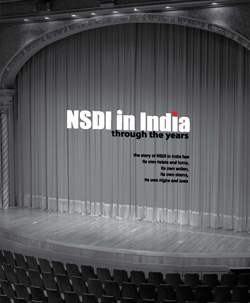


Leave your response!